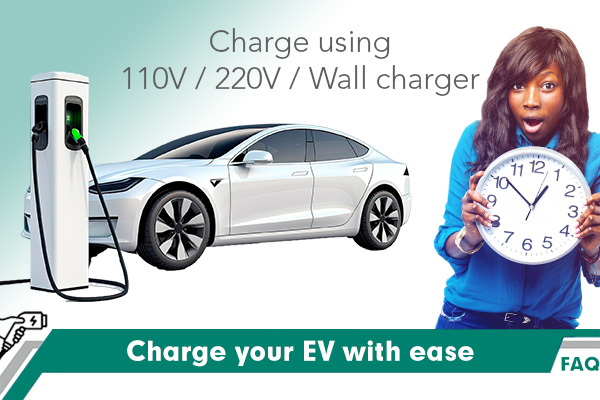
Did you know you can use a regular wall-outlet to charge the Electric Car?
Our EV’s come complementary with an electric charge cable which can be used in 220V, and even 110V outlets
However, … (this is the part you expected)
Even though a regular wall-outlet can be used, it is not really advisable for the larger Electric Cars, or better said; the high-capacity car batteries.
The ‘power’ that a wall-outlet can give to charge the car is limited, so charging can take a long time.
It will be more than sufficient for a car with a small battery, but for the larger cars or long-range batteries we advise to use a specialized wall-charger.
Estimated Electric Car charging times
I won’t bother you on how it all works, but I can tell you that 110V will give the least power, followed by the 220V, and at last the wall-charger will give you the most power to charge up your car. That is why charging using a 110V outlet will take a lot longer than charging using a wall-charger.
So, what are the charging times if you use a 110V outlet, a 220V outlet, or the special wall charger? I will give you the estimated times it takes to charge your car battery.
A small Electric Car or small-capacity battery
A small battery (small car) on Curacao has on average a capacity of 30 kWh.
To charge the car from 20% to 80%, you should expect the following charging times:
 |
Using the 110 volt outlet, the car will take 14 hours to charge. |
 |
Using the 220 volt outlet, the car will take 7 hours to charge. |
 |
Using the special wall-charger the car will take 3 hours to charge. |
A large Electric Car or high-capacity battery
A high battery capacity car on Curacao has on average a capacity of 65 kWh.
To charge the car from 20% to 80%, you should expect the following charging times:
 |
Using the 110 volt outlet, the car will take 30 hours to charge. |
 |
Using the 220 volt outlet, the car will take 15 hours to charge. |
 |
Using the special wall-charger the car will take 6 hours to charge. |
Using those estimates, you can plan your charging schedule. What time do you need to charge the car for the next trip? Or is 110V/220V charging sufficient in your particular case? Now you know.
Bear in mind that it will not happen often that your battery will be depleted to 20% remaining capacity or less. So, the charging times will often be much less.
In daily life, you might go to the mall and plug your car to one of the public chargers which will add mileage to your remaining range.
Or you go to your workplace and plug in for some extra range.
When you come home after a day’s work, just plug-in your car, have a sound sleep, and the next morning your car is ready for the next day. Just like you do with your cellphone.
In time you will gain experience on the remaining range you have left in your battery and whether or not you need to charge.
What about Fast DC Charging on Curacao?
In Europe and the US it is very common to use Fast DC Charging. High power charging which is able to ‘fill’ your battery in about 20 minutes.
This is very useful when driving long distances like in the US or Europe. On Curacao however, there is no need for that. Our island is relatively small and usually we don’t drive hundreds of miles/kilometers per day.
It will be very rare you need to ‘extra-charge’ on the same day, as the capacity of the batteries will be more than adequate to get you around the island. Charge your car at night and you’ll be ready to go for the entire day, or charge at one of the public chargers during the day. That is why you won’t see any infrastructure for fast chargers on Curacao. (In fact, there is only one 22kW charger available on the island.)
Also, fast-charging is bad news for your car-battery as it will degrade faster. So, we don’t advise using fast-charging.
Concluding; On Curacao there’s no need for Fast DC charging, and it is better not to use it at all to extend the battery lifespan.
Disclaimer:
All calculations are based on averages. Your specific make and model will affect the calculations. We have used the tariffs as of April 2024. We have not included our calculations in this article as to enhance readability.
